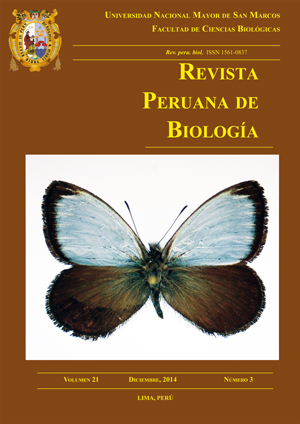Dynamics, aboveground biomass and composition on permanent plots, Tambopata National Reserve. Madre de Dios, Peru
DOI:
https://doi.org/10.15381/rpb.v21i3.10897Keywords:
RAINFOR, lowland Amazon rainforest, mortality, recruitment, aboveground biomass, Tambopata.Abstract
In this study we evaluated the floristic composition and changes in stored biomass and dynamics over time in 9 permanent plots monitored by RAINFOR (Amazon Forest Inventory Network) and located in the lowland Amazon rainforest of the Tambopata National Reserve. Data were acquired in the field using the standardized methodology of RAINFOR. The biomass was estimated using the equation for tropical moist forests of Chave et al. (2005). Biomass dynamics were analyzed, in three separated periods from 2003 to 2011. 64 families, 219 genera and 531 species were recorded. The tree floristic composition is very similar in all plots except for one swamp plot, although but it is also evident that two slightly different forest communities exist in the rest of landscape, apparently related to the age of the ancient river terraces in the area. Mortality and recruitment of individuals averaged 2.12 ± 0.52% and 1.92 ± 0.49%, respectively. The turnover rate is 2.02% per year. Aboveground biomass stored in these forests averages 296.2 ± 33.9 t ha-1. The biomass dynamics show a total net gain of 1.96, 1.69 and –1.23 t ha-1 for period respectively. Prior to the drought of 2010 a change in biomass was found 1.88 t ha-1 yr-1 and post drought was -0.18 t ha-1 yr-1 on average, though the difference is not significant. Demographic analysis suggests a dynamic equilibrium in the plots. The negative balance of biomass observed for the period 2008 – 2011 may be due to the drought of 2010, in which half of the monitored plots experienced negative net biomass change due to mortality of individuals selectively affecting the floristic composition.Downloads
Downloads
Published
Issue
Section
License
Copyright (c) 2014 Nadir C. Pallqui, Abel Monteagudo, Oliver L. Phillips, Gabriela Lopez-Gonzalez, Luciano Cruz, Washington Galiano, Wilfredo Chavez, Rodolfo Vasquez

This work is licensed under a Creative Commons Attribution-NonCommercial-ShareAlike 4.0 International License.
AUTHORS RETAIN THEIR RIGHTS:
a. Authors retain their trade mark rights and patent, and also on any process or procedure described in the article.
b. Authors retain their right to share, copy, distribute, perform and publicly communicate their article (eg, to place their article in an institutional repository or publish it in a book), with an acknowledgment of its initial publication in the Revista Peruana de Biologia.
c. Authors retain theirs right to make a subsequent publication of their work, to use the article or any part thereof (eg a compilation of his papers, lecture notes, thesis, or a book), always indicating its initial publication in the Revista Peruana de Biologia (the originator of the work, journal, volume, number and date).






